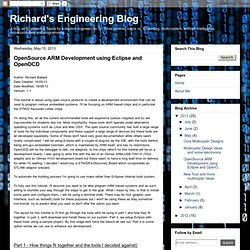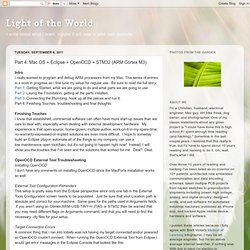

Richard's Engineering Blog: OpenSource ARM Development using Eclipse and OpenOCD. Author: Richard Ballard Date Created: 15/05/13 Date Modified: 19/06/13 Version: 1.1 This tutorial is about using open source products to create a development environment that can be used to program various embedded systems.

I'll be focusing on ARM based chips and in particular the STM32 flavoured cortex chips. I'm doing this, as all the current recommended tools are expensive (unless crippled) and so are inaccessible for students like me. To automate the building process I'm going to use make rather than Eclipses internal build system. To fully use this tutorial, I'll assume you want to be able program ARM based systems and as such willing to stumble your way through the steps to get to the goal.
The layout for this tutorial is I'll first go through the tools we'll be using in part 1 and how they fit together. Part 1 - How things fit together and the tools I decided against) Below are a list of the tools and components we'll be using in our development environment. Eclipse [1] Our IDE. The ODeV Idea. The Firmware Component Architecture There is another concept I need to explain before start using the IDE.

It is the Firmware Component Architecture. Each part of ODeV is designed in order to make easy to build firmware in a modular way. The target of a firmware component is to provide a set of source files exporting some features organized in a set of related tasks. But it is not only source files. Let me show an example. ‣The ST Standard Library for STM32F107 ‣The FreeRTOS scheduler ‣The FreeRTOS Extension Class (to provide C++ API to FreeRTOS) ‣The Application specific files. Figure 1 shows the dependence diagram of these components. Fig.1 - The Components Dependence Graph Each component is an Eclipse Project.
Fig.2 - Eclipse Workspace There are two fundamental type of components: ‣Application Component ‣Library Component For example the FreeRTOS component is a Library. The Firmware Component Directory Structure Fig.3 - Directory Structure. Light of the World: Part 4: Mac OS + Eclipse + OpenOCD + STM32 (ARM Cortex M3) Intro I really wanted to program and debug ARM processors from my Mac.

This series of entries is a work in progress as I fine tune my setup for regular use. Be sure to read the full story:Part 1: Getting Started, what we are going to do and what parts we are going to use.Part 2: Laying the Foundation, getting all the parts installed.Part 3: Connecting the Plumbing, hook up all the pieces and run it. Part 4: Finishing Touches, troubleshooting and final thoughts. Finishing Touches I know that established, commercial software can often have more start-up issues than we care to deal with, especially when dealing with external development hardware. My experience is that open-source, home-grown, multiple-author, work-on-it-in-my-spare-time, no-warranty-expressed-or-implied solutions are even more difficult.
OpenOCD External Tool TroubleshootingInstalling OpenOCD I don't have any comments on installing OpenOCD since the MacPorts installation works so well. Error: JTAG-DP_STICKY_ERROR. Embedded Programming on the Mac. Setting up Eclipse and Code Sourcery lite for STM32 Discovery Development - The STM32 Discovery Scrapbook from Nano Age. Here is a step by step guide to setting up a Open Source Stm32 Arm based embedded development tool chain with the Eclipse IDE. It is Targeted for the ST32-Discovery demo board under Windows (This was implemented under Windows 7 64bit) and uses the open source Code Sourcery version of the Gnu Arm cross assembler. The project will be set up to use the Arm CMSIS Library which provides a common infrastructure for Arm MCU's and the Standard Peripheral Library so you should be able to run any of the STM32 Discovery example projects with this configuration. First The Requirements. This is what you will need to download The Java JRE from here if you don't already have Java installed (This is needed to run Eclipse) The Eclipse Helios IDE for C/C++ Developers available from here.
Big Mess o' Wires » Cortex M3 For Dummies – STM32 Discovery Board. The ARM Cortex M3 has generated lots of buzz lately.

Maybe you’ve been working with Arduinos, AVRs, or PICs for a while, and heard about the Cortex M3, but weren’t sure what it was all about or whether it was even relevant to you. This review will try to shed some light on the Cortex M3′s capabilities and development tools, using the STM32VLDiscovery board from ST Microelectronics. The nice folks at Newark sent me a STM32VLDiscovery Cortex M3 evaluation board for review. This little board packs a big bunch for a remarkably low price. It can be found for under $10 if you hunt around for a deal, which is an amazing value.
Although the STM32 Discovery board isn’t marketed as an Arduino competitor, it could be one. The table makes it clear that you’re getting a lot of microcontroller for your money. Instructables - Share What You Make.